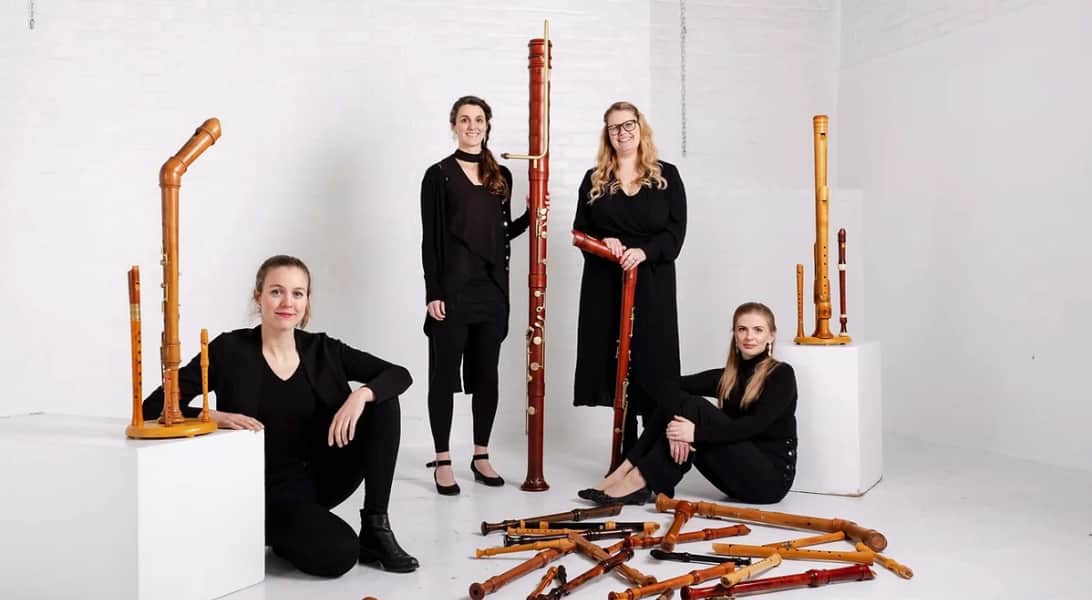
Palisander
Tabea Debus – recorder
Caoimhe de Paor – recorder
Miriam Monaghan – recorder
Lydia Gosnell – recorder
| ROBERT FAYRFAX | That was my Woo |
| KING HENRY VIII | The Kynge’s Balade |
| Catherine of Aragon | |
| ANON | Din Dirin |
| ANON | La Spagna I |
| JOSQUIN DES PREZ | Absalon fili mi |
| MIRIAM MONAGHAN | The Pomegranate |
| Anne Boleyn | |
| THOINOT ARBEAU | Pavane |
| CLAUDIN DE SERMISY | Jouissance vous Donneray |
| KING HENRY VIII | Helas Madame (arr. Monaghan) |
| ANNE BOLEYN | O Death, Rock me to Sleep |
| MIRIAM MONAGHAN | The Falcon |
| Jane Seymour | |
| JOHN TAVERNER | In Nomine |
| KING HENRY VIII | Tander Naken |
| PHILIP VAN WILDER | Fantasia con Pause |
| MIRIAM MONAGHAN | The Phoenix |
| TRADITIONAL | Haste to the Wedding (arr. Monaghan) |
| Anne of Cleves | |
| ANON | Danse de Cleves (arr. Monaghan) |
| HAYNE VAN GHIZEGHEM | Allez Regrets |
| WILLIAM CORNYSH | Adieu! mes amours |
| MIRIAM MONAGHAN | The Swan |
| Catherine Howard | |
| ANON | Allemande Prynce (arr. Monaghan) |
| MICHAEL PRAETORIUS | Three Volte |
| CIPRIANO DE RORE/RICCARDO ROGNONI | Anchor che vol Partire |
| MIRIAM MONAGHAN | The Tudor Rose |
| Catherine Parr | |
| GIOVANNI BASSANO | Ricecare 11 |
| CHRISTOPHER TYE | The Acts of Apostles, ‘When that the people taught they had’ |
| THOMAS TALLIS | If Ye Love Me |
| MIRIAM MONAGHAN | The Wheel |
| KING HENRY VIII | The Kynge’s Balade |
Divorced, Beheaded, Died
Palisander prides itself on presenting imaginative, historical programmes with a wide range of repertoire; performing largely from memory, on recorders up to 6 feet tall. The quartet has quickly established itself as a vibrant young ensemble. Devising their own choreography, as well as writing new compositions and unique arrangements for the ensemble, the group’s members are keen ambassadors for the recorder’s versatility.
Whilst this programme’s repertoire centres on one specific period, Early Tudor England, Palisander’s signature blend of movement, spoken word, additional percussion and singing combine to create a unique historical concert experience. ‘Divorced, Beheaded, Died’ follows the unfortunate stories of the women behind the rhyme: Henry VIII’s six wives. It includes music written for, inspired by and curated by these Queens, alongside historical accounts of the role music played in their lives. The repertoire includes historically informed performance practice from the golden age of consort writing, alongside sensitive bespoke arrangements for recorders, bringing Tudor England to life.
Described as “Early Music’s very own Spice Girls”, Palisander enjoys giving regular family concerts and educational workshops, including partnerships with Live Music Now and Wigmore Hall. We are therefore delighted that the group will also be the guest artists for our annual afternoon Schools Concert.
Please note that both the afternoon and evening events will take place ‘in the round’ with the artists performing at ground-floor level.
To find out more about the quartet, see www.palisanderrecorders.com
Photo credit: Becky Mursall
With the support of a generous legacy from Dr Philip da Costa
Review
Recorders great and small at Skipton Music
The Palisander Ensemble held a capacity audience enthralled at last week’s concert in Skipton Town Hall, the fifth of this season’s concerts for Skipton Music. The ingenious programme was built round the theme of the six wives of Henry VIII, and each ‘wife’ was introduced in engaging manner by the ensemble, outlining key aspects of their reign and the music which they would have enjoyed. Fittingly, Henry himself had the first and last word with ‘The Kynge’s Balade’.
The ensemble play a formidable array of recorders, great and small. For much of the programme they used a matched set of renaissance recorders, ranging from the enormous contrabass to the tiny sopranino, with a wonderfully mellow and sweet sound. It was an especial delight to hear the ‘great consort’ of four low-pitched recorders. This was especially effective in slower pieces such as de Rore’s sublime ‘Anchor che vol Partire’ and Tallis’ ‘If ye love Me’; but even the contrabass recorder in such skilled hands sounded amazingly mobile in faster pieces. There was opportunity too to enjoy the agility and brilliance of the higher pitched instruments, with each of the three ‘volte’ from Praetorius’ collection of dance music progressively higher and faster.
This was not altogether a concert for purists. The ensemble play renaissance music with great style and sensitivity, with a tasteful and not excessive use of ‘divisions’ (decorations). But several of the pieces were ‘arranged’, no doubt with the best of intentions: the result was some very odd harmonic progressions which in Henry’s day would have resulted in a lengthy sentence in the Tower! And your reviewer was not completely convinced by the addition of compositions in a contemporary folk style. I recognise that the ensemble want to make the music accessible but surely there is already enough variety in this attractive programme without adding further elements? But these are minor cavils to what was a most enjoyable evening.
Charles Dobson
